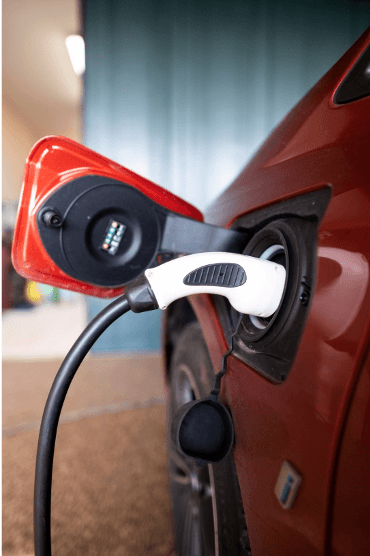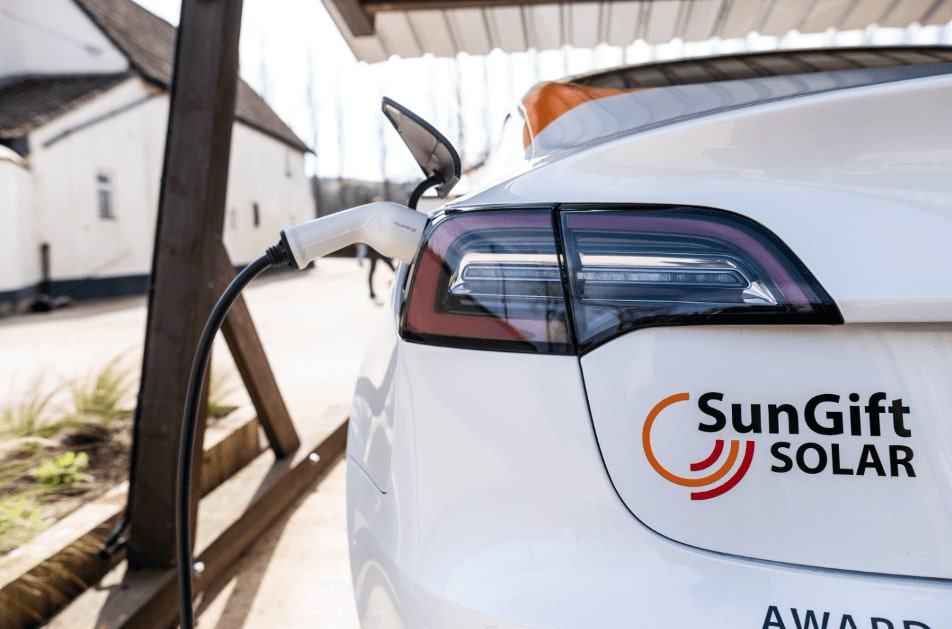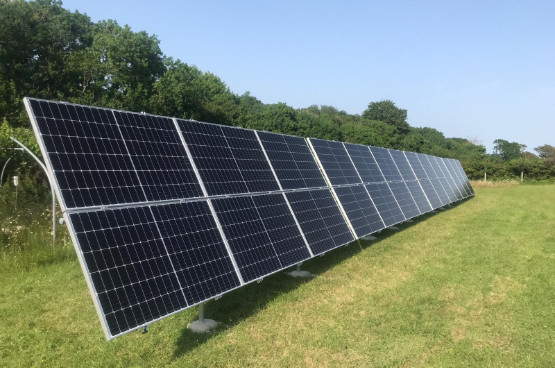Would you like to charge up your electric vehicle (EV) with free, clean energy? With a solar car charger you can do just that.
It is widely accepted that the mass rollout of solar PV and EVs will be a fundamental part of the switch away from fossil fuels and towards a renewable, zero-carbon future (alongside wind and hydrogen). So why not combine these two amazing bits of technology at your home now and start reaping the rewards?
A 4kWp solar PV system in Exeter, facing due south and pitched at 35 degrees with no shading, can expect to generate up to roughly 4800 kWh of energy per year*. Ollie’s Tesla Model 3 EV uses roughly 0.25kWh to drive 1 mile (he is a very sensible and efficient driver). That means that the 4800 kWh of solar generation is the equivalent to 19,200 miles in Ollie’s Tesla. The average annual mileage of a car in England is about 7600 miles (National Travel Survey: England 2018). This means that a 4kWp solar PV system, over the course of a year, can generate roughly 2 and a half times the amount of energy required for an average EV.
You’ll probably use the majority of your generated PV energy to power your home appliances, heat water or charge a home battery. However, this example gives you a good idea of how much potential there is for solar EV charging. If you managed to put just 40% of the 4800 kWh into your EV, that would get you the full 7600 miles. Even if you managed only 20%, that would get you 3800 miles, or half of the annual average mileage.
In this blog post, we’ll start off with the basic principles of EV charging. Then we’ll move on to the different types of chargers available, ending with solar EV charging. Spoiler alert – the best chargers give you total control of how your EV charges and can divert surplus energy from your solar PV into your car’s battery.
* If you need a quick tutorial on what terms like kWp and kWh mean, then scroll down to the bottom of this article where I’ll explain what they mean in more detail.
Case Study – Ollie Gibbs (SunGift Solar Renewable Energy Specialist)
I mentioned Ollie and his Tesla Model 3 in the introduction. His full renewable energy set-up also includes a 4kWp solar PV system and the Zappi Solar EV charger (more on the Zappi later). I’ll keep referring back to this case study as it is an excellent example of combining multiple technologies to maximise Ollie’s self-consumption which in turn is good for the environment and saving money.
This table shows all the key details of Ollie’s EV and PV system. The numbers in this table are mostly from Ollie’s experience, rather than what is listed in the car specifications.
| Usable EV Battery Capacity | Real-Life Range | kWh needed to drive 1 mile | Time to charge at 7kW | Time to charge with 3-pin plug | Annual Solar PV Generation |
| 47.5kWh | 220 miles (summer) 200 miles (winter) | 0.20kWh (summer) 0.25kWh (winter) | About 7 hours | About 21 hours | About 3600kWh |
EV Charging Basics
First of all – do you even need a charging point installed for your EV? The short answer is no, technically you don’t. But, you’ll really wish you had one.
Most EVs come with two charging cables.*
Cable number 1 is a UK plug to Type 2 cable. This means you can plug your EV into one of the standard 3-pin plug sockets in your house or garage, to charge. This method bypasses the need to install a dedicated EV charge point. The downside is that the charging speed will be slow – you can expect an average charging speed of around 2.4kW (it will vary throughout the day). That’s about 11-12 miles of range per hour charging for Ollie’s Tesla. He would need to leave his car plugged in for over 20 hours to charge from 0 to 100%.

Type 2 to Type 2 cable. This cable needs to be plugged into a dedicated EV charging point with a Type 2 adaptor.
Cable number 2 is a Type 2 to Type 2 cable. This cable needs to be plugged into a dedicated EV charging point with a Type 2 adaptor. With one of these, you can charge your EV at much faster speeds, typically at about 7kW for domestic properties. That’s about 31-32 miles of range per hour charging for Ollie’s Tesla, cutting his time for a full charge down to roughly 7 hours.
*This is a big simplification of the types of charging cables available. Type 2 is the most common AC charging cable so I’m using it for this article. The other AC charging cable is Type 1, although it is getting gradually phased out by Type 2. DC charging cables include CCS and CHAdeMO – these are for rapid charging stations which you can’t get at domestic properties.
Not all EV chargers are created equal. Some are ‘smart’ and some are ‘dumb’. What determines the intelligence of an EV charger?
A ‘dumb’ charger is one that performs the minimum charging function. You plug your EV into the charger and it will charge your EV at the fastest speed available, often 7kW for residential chargers.
A ‘smart’ charger can do so much more. The fundamental principle of a smart charger is that it has internet connectivity. This allows advanced monitoring and remote control of your charger, usually via a smartphone app. This allows you to remotely start, stop and schedule your charging via your phone. You can also monitor your charging and utilise the time-of-use electricity tariffs. Crucially, smart chargers are eligible for the OLEV grant. The OLEV grant is a £350 contribution towards your charging point from the government and is available for homes and businesses. A dumb charger might initially appear to be the cheaper option, but once the OLEV grant is applied, it nearly always makes financial sense to go with a smart charger.
Smart chargers can also integrate with your solar PV system, which I’ll discuss in the next section.
The key benefits of installing an EV charging point are:
- Charge your EV much faster at speeds, usually around 7kW for domestic properties
- You can make use of the £350 government grant towards the charging point (smart charger only)
- Monitor and remotely control your EV charging via a smartphone app (smart charger only)
- Charge your EV for less by scheduling charges with off-peak electricity tariffs (smart charger only)
- Charge your EV directly from your solar panels (certain smart chargers only – see next section)
Solar EV Charging
How can I charge my EV from my solar PV system?
By this point, your EV charging point is so much more than just a fancy plug socket for your car.
An EV charge point with solar PV integration will monitor your house’s energy consumption and compare it to your solar PV generation. When there is a surplus of energy from the solar PV, rather than exporting this energy back to the grid, it will use it to charge up the EV battery.
The easiest way to explain this is with an example.
Let’s say your PV system is generating 3kW, but your house is only using 1kW. The remaining 2kW has to go somewhere. Without a solar EV charger, this energy will get sold back to the grid for a maximum of 5.5p/kWh under the Smart Export Guarantee (SEG). However, with a solar EV charger, the remaining 2kW will be diverted into your EV battery. The charger will continually monitor your surplus solar PV generation and adjust the EV charging rate accordingly.
In this example, let’s say it’s a sunny, clear day and your PV system generates 20kWh in total. Your house only used 5kWh during this time. If the EV was plugged in all day, the EV charger will have diverted the surplus 15kWh of energy into the EV battery. That’s about 67 miles of range in Ollie’s Tesla, the equivalent of a round trip from Exeter to Taunton.
Now that we know how solar EV charging works, I’ll walk you through one of our favourites chargers, the Zappi.
What is a Zappi?
The Zappi is a smart EV charger made in Britain by a company called MyEnergi. When it comes to solar EV charging, the Zappi is in pole position.
There are three different charging modes to try out.
- Fast
- Eco+
- Eco
Fast Mode
Just got back from the shops and need to head out again in an hour? Car battery nearly empty? This is when Fast mode is great. In this mode, the Zappi will simply charge your EV as fast as possible (usually 7kW). The Zappi will take the full 7kW regardless of how much your solar PV is generating. This means that you will need to import some energy from the grid when using this mode.
Eco+
Not going to use your EV today? This is where the Zappi comes into its element. In Eco+ mode, the Zappi will only charge from any surplus PV energy you are generating. This is perfect if you plan on leaving the EV plugged in for several hours during the day. The surplus solar energy will be trickle fed into the EV battery. With no energy coming from the grid, this is the greenest way to charge your EV.
Most EVs have a minimum charging rate of 1.4kW. If your surplus solar generation falls below 1.4kW, then the EV will stop charging. For example, if your house is demanding 1kW, your solar PV system will need to be generating 2.4kW or more for the Zappi to start charging the EV in Eco+ mode.
Eco
Eco mode is very similar to Eco+ mode, but with one key difference. If the surplus solar PV generation falls below 1.4kW, the Zappi will draw the extra energy required from the grid, to ensure that EV is always charging at a minimum of 1.4kW. For example, your house is demanding 1kW and your solar PV system is generating 2kW. There is a surplus of 1kW from the solar, which is not enough to start the EV charging (minimum 1.4kW). In Eco mode, the Zappi will draw the remaining 0.4kW from the grid in order to start the charging process.
With the extra Hub device (also made by MyEnergi), you can control and monitor all of the Zappi features and modes. Ollie even made a short video explaining how he uses his own Zappi at his house, watch it here.

Another shot of Ollie’s Tesla, this time being charged up by our solar carport.
Other EV charge point manufacturers have similar solar smart chargers, but none offer the full package like the Zappi. Alternative options include the EO Smart Home EV Charger. With this model you can charge in the equivalent of Fast and Eco mode, but not Eco+. SolarEdge also makes a solar EV charger, but only has the equivalent of Fast and Eco+ mode (you also need a SolarEdge PV system, whereas the Zappi is compatible with any PV system).
Is solar EV charging for me?
This might all sound fantastic, but will it suit your needs?
The first thing you might want to consider is – when will you typically charge your EV? The more time your EV spends parked on the driveway during the day, the more you will benefit from solar charging. But what if I drive my EV to work 5 days a week? Firstly, you’ll still be able to benefit from solar charging at the weekends and holidays. Secondly, you might be able to benefit from a small amount of solar EV charging in the evenings.
In the UK summertime, the sun can set as late as 9:21pm, so even after work, there are a few hours in which to benefit from solar charging. It may not seem like much, but over the course of the summer this could add up to some significant mileage. Let’s say that between May-August you charge your EV for 1 hour each evening at the minimum threshold of 1.4kW. That’s 1.4kWh per day for 123 days, totalling 172kWh. This is the equivalent of about 860 miles of summer driving in Ollie’s Tesla – nothing to shy away from!
Secondly, how big is your PV system? If your PV system size is only 2kW, then it will be a rarity that the PV will generate enough surplus to get above the 1.4kW starting threshold. A better way to increase your solar self-consumption might be through battery storage or immersion diversion.
Finally, what sort of demand will be coming from your house? If you use a lot of energy during the day or plan to store surplus solar energy in a home battery or by heating water, then you might not have much of a surplus leftover to be diverted into the EV. However, the Zappi is fully compatible with battery storage, allowing you to prioritise where your surplus solar energy goes.
So in Conclusion…
Solar EV charging is a great way to ensure that your EV is constantly topped up with clean energy from your solar PV system. The key benefits are:
- Energy from your solar PV is free, so it will make driving much cheaper
- Increase your solar self-consumption. The surplus energy would have otherwise been sold back to the grid for a maximum of 5.5p/kWh. With a solar EV charger, each kWh that goes into your EV saves you 15p – another financial incentive
- Environmentally, charging your EV from your solar PV is emissions-free. The UK grid electricity mix is made up of predominantly fossil fuels (mainly gas), renewable (mainly wind and solar) and nuclear power, so charging an EV from the grid isn’t technically an emissions-free process. You can monitor the UK electricity grid mix here, http://grid.iamkate.com/. At the time of writing, renewables are providing 41.6% of national electricity demand!
Let us know if you are interested in charging your EV from solar power and we will do our best to get you driving on sunshine!
Contact us here.
Appendix – Terminology, definitions and units
Let’s quickly go over some of the terminology we’ll be using in this article. The only thing you need to know is this simple equation below, which I’ll be referring back to.
Power (Watts) = Energy (Joules) / Time (Seconds)
- Power (Watts, W). Power is a measure of how quickly energy is transferred. The unit we use to measure power is watts. Every electrical appliance in your house will have a power rating. For example, a typical domestic EV charger uses about 7000W of power and a kettle uses about 2000-3000W
- Kilowatts (kW). One kilowatt is simply 1000 watts (like how one kilometre is 1000 metres). We tend to deal with thousands and sometimes millions of watts at a time, so using kW makes life a bit easier. Going back to the previous example, we would say that a typical EV charger uses about 7kW of power
- Energy (Joules). Energy is generated (from solar PV, wind, etc.), transferred to our houses via the national grid then finally transferred into our electrical appliances where it is consumed. The equation above can also be written as: 1 joule of energy will be used when a 1-watt appliance is turned on for 1 second
Therefore, another word for Joule is watt-second. We like to deal in kilowatts (kW) rather than watts, and hours (h) rather than seconds. The result is that energy is most often expressed as kilowatt-hours (kWh), rather than joules.
Here are some kWh examples to give you some context.
- The average UK household uses roughly 4000 kWh per year (that’s about 11kWh per day)
- Ollie’s 2019 Tesla Model 3 Standard Range EV has a 53.6kWh battery (that’s a 220-mile range according to Tesla)
- An iPhone battery is about 0.01kWh
Finally, here is an example of how it applies to charging an EV
Let’s say Ollie wants to charge his Model 3 from 0 to 100% as quickly as possible at home. In theory, this would take just over 7 hours if he charged at a constant rate of 7kW. However, to protect the battery and prolong its life, Tesla has ensured that charging speeds are slowed down towards the end of the charge. This means a full charge would take somewhere between 7-11 hours.
Another important metric is how many watt-hours are needed to drive one mile in your EV. The Model 3, with a 53,600 watt-hour battery and a 220-mile range, this equates to 244 watt-hours per mile (Wh/m). However, Ollie is a sensible and efficient driver, which means he only uses about 200 Wh to move 1 mile.
Sources
National Travel Survey: England 2018 – https://www.racfoundation.org/motoring-faqs/mobility#a25

 Solar PV Contractor of the Year 2024
Solar PV Contractor of the Year 2024
